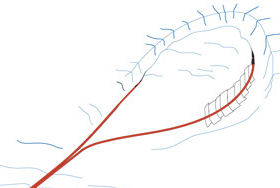The poor weather forecast forced us to relocate our snow weekend on the 6-8th September from Blue Lake to the Four Mile Hut – probably for the best in hindsight.
The Four Mile Hut, located in the Selwyn area of Kosciuszko National Park, was built in 1937 by Robert Hughes as a base for gold fossicking, fishing and rabbiting. We decided to return there as a few of us had been there in 2018 thanks to Ben running a fantastic cross-country skiing trip. Sadly, the hut was destroyed earlier this month to the devastating 2020 bushfires.

At the end of June we were advised to take any opportunity you may have to get out and learn Snow craft skills. The more knowledge you have in this area, the better. The primary goal of the trip was therefore to practise snow craft. Snow craft is a term that covers skills that are required for snow ascents, for example use of ice axe and crampons, navigation, self-arrest, avalanche rescue, anchor building. Here’s a brief summary of the snow skills that we practiced on the trip:

Snow shelters
Shelter is one of the most important needs for survival in bad weather. Building a snow shelter is time consuming (as we discovered!) but can be more secure and warmer than a tent during a winter storm. Depending upon snow conditions and location, there are a few different designs:
Snow trench – can be combined with a winter tent, bivy or tarp. We found that digging out a vestibule for the club second arrow winter tents works really well.

Quinzee – if there’s not enough snow, the technique is to make a pile of snow and carve out the middle. This is what we did on the trip 🙂
Snow Cave – if there’s lots of snow around it is possible to dig into the hillside to form a snow cave, see diagram.
Igloo – requires skill and cold temperature as they can be more susceptible to melt and collapse.
Other factors to consider:
- Having a smooth ceiling helps to minimise melt-water inside the shelter. Having said that, try not to be overly enthusiastic with smooth the ceiling that in becomes very thin or creates a hole…
- Do not cook inside the snow shelter – there is a risk of carbon monoxide poisoning due to poor ventilation
- Use ski poles with baskets to poke ventilation holes in the ceiling to prevent asphyxiation.
- The smaller the shelter the warmer it will be
- Choose a location clear of avalanche hazard!


Snow anchors
T-slot with ice axe(s) – dig a slot at least 30 cm deep (dig deeper in softer snow) perpendicular to the direction of pull. Make a narrow groove for the sling perpendicular to the slot (same depth). Clove hitch a 120 cm sling to the middle of the ice axe and place into the built structure. A second ice axe can be added for reinforcement, see picture.
Snow bollard – make a big pile of compacted snow and place the rope around it or dig a horseshoe shaped trench and slot the rope in the trench. Test the anchor out with a backup in place! The softer the snow, the bigger the bollard should be (minimum 1m diameter).

The T-slot and snow bollard anchors are suitable in varying snow conditions. Other more condition dependent anchor systems include ice screws, V-thread, Top clipped snow stake, Mid clipped snow stake and T-slot with a snow stake, which were able to practise on the course in NZ. Note, with all snow anchors, shock loading should be kept to a minimum (avoided).
Crevasse rescue – we attempted to practice crevasse rescue but the shallow angle of the slope made it a bit unrealistic…

Snow shoeing – due to the soft nature of the snow, use of crampons was unsuitable. The larger surface area of snow shoes means that you don’t sink into the snow quite as far so each step saps less energy from your legs!
Why the trip was valuable preparation for New Zealand:
- Snow craft practice
- Experience using snowshoes
- Opportunity to test our gear out
- Group bonding
- Indicator of how long it takes to make decisions in a group of 8
Given that we didn’t make it to Blue Lake, I think we are all keen to get down there for club trips this year!

References:
http://www.nordicskiclub.org.au/Publicinfo/Huts.html
https://m.outdoorrevival.com/old-ways/survival-shelters-snow-caves-how-to-build-one.html
Mountaineering: The Freedom of the Hills

